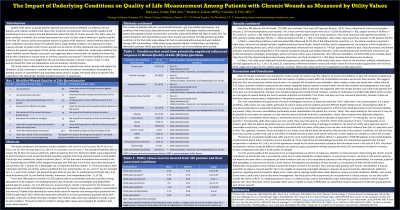Clinical Research
(CR-003) The Impact of Underlying Conditions and Comorbidities on Patient Quality of Life Characterized by Utility Values

To understand the impact of underlying conditions/comorbidities on patient quality-of-life as characterized by utility values in a real-world patient population with chronic wounds of different etiologies and duration.
Methods:
This analysis involved a representative, convenience sample of sequential patients seen at a hospital-based outpatient wound center. Data from all patients who could fill out the w-QoL questionnaire on an electronic tablet during their first visit and had additional conditions/comorbidities were included. Data were transmitted to a registry, which generated a per-patient list of all conditions/comorbidities plus their wounds. Median utility values for every comorbidity/condition were calculated from relevant utility values in the Tufts Cost-Effectiveness Analysis Registry supplemented by literature searches. Patient utility values were calculated using means, medians, additive, multiplicative, minimum, and adjusted decrement estimator approaches. The frequency and proportion of patients with underlying gait and mobility issues, morbid obesity, and anxiety and/or depression were also determined.
Results:
Data on 388 patients with wounds were captured from June 26, 2014, through March 10, 2016; 6 (1.5%) patients had no comorbidities/conditions and were excluded. Among the 382 patients analyzed, the mean (SD; range) number of conditions per patient was 8 (3.9; 2-26). Two-hundred and thirty (60.2%) had lower/worse utility values for comorbidities/conditions than their wounds’ values. Sixty-three (16.5%) patients had depression and/or anxiety, 64 (16.8%) had morbid obesity and 204 (53.4%) had gait and mobility abnormalities, all of which limit scores for mobility/activities. Median values for the mean, median, and minimum approaches yielded utility values of 0.726, and 0.756, and 0.520, while other approaches yielded unrealistically low values.
Discussion:
Most real-world patients with wounds have many preexisting conditions that are worse than wounds alone and would likely result in negatively answering many quality-of-life questionnaires, regardless of wound status. The most appropriate method to calculate utility values for patients with many comorbidities might be the minimum approach. Consequently, in wound care, consideration of the patient’s most impactful comorbidities must be considered when assessing quality of life.
Trademarked Items:
References:

.png)
